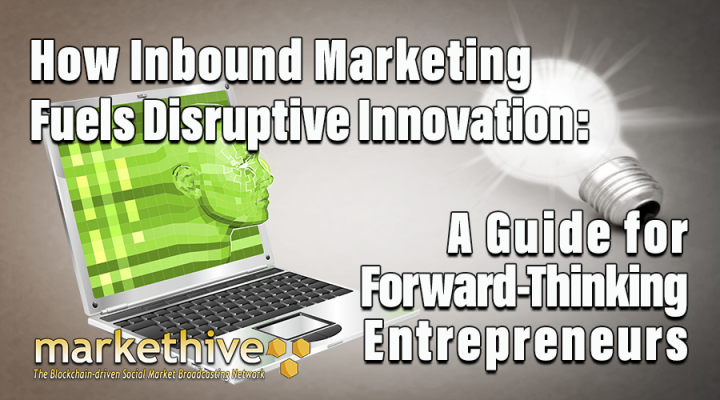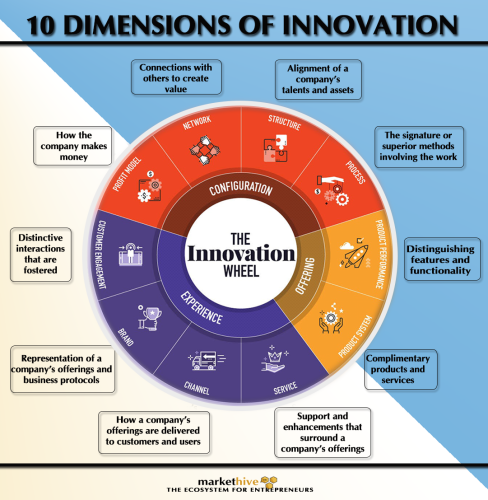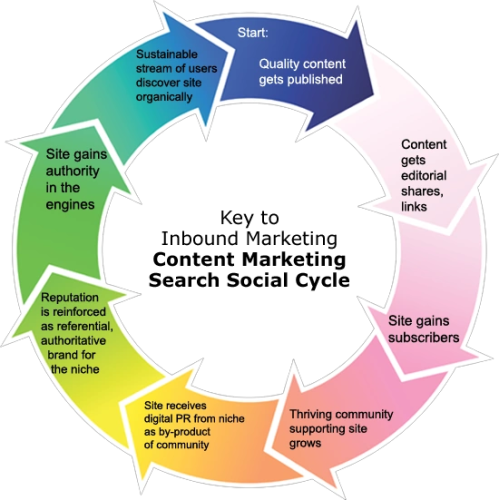
How Inbound Marketing Fuels Disruptive Innovation: A Guide for Forward-Thinking Entrepreneurs

In today's fast-paced and rapidly evolving business landscape, traditional marketing strategies are no longer sufficient to drive innovation. To stay ahead of the curve, forward-thinking businesses turn to inbound marketing as a powerful tool to fuel disruptive innovation. In this guide, we will explore the concept of inbound marketing, its role in fostering disruptive innovation, and the benefits it offers to entrepreneurs.
Inbound marketing is a strategic approach focusing on attracting, engaging, and delighting customers through valuable content and experiences. Unlike traditional outbound marketing, which relies on interruptive tactics like cold calling and advertising, inbound marketing aims to build long-term relationships with customers by providing them with relevant and helpful information. By leveraging content marketing, social media, and search engine optimization (SEO), inbound marketing creates a magnet-like effect, organically drawing customers to your business.
Understanding Disruptive Innovation
To understand how inbound marketing fuels disruptive innovation, we must first grasp the concept of disruptive innovation itself. Disruptive innovation refers to the process by which a new product or service disrupts an existing market by offering a unique value proposition. This innovation often starts at the fringes of the market, targeting underserved customers with a novel solution that addresses their unmet needs.
Disruptive innovation challenges the status quo, and forces established players to adapt or risk becoming obsolete. Examples of disruptive innovations include the advent of smartphones, which revolutionized the telecommunications industry, and online streaming services, which disrupted the traditional television and movie rental market. By leveraging inbound marketing, businesses can identify and capitalize on disruptive innovations that have the potential to shape the future.
Now, here's where inbound marketing steps in. Businesses can spot these disruptive innovations early on by using inbound marketing techniques, like creating engaging content or building strong relationships with potential customers. This means they can get in on the action and take advantage of these groundbreaking ideas before they become mainstream.
So, inbound marketing isn't just about attracting customers—it's also about staying ahead of the curve and spotting the next big thing that could shape the future.

The Role of Inbound Marketing in Fueling Disruptive Innovation
Inbound marketing is like the fuel for those game-changing, disruptive ideas. It gives them a stage to shine on and get noticed. Imagine you've got this amazing new solution to a problem nobody's really tackled yet. Inbound marketing helps you get the word out in a way that grabs people's attention.
First, you create content that speaks to the folks who are feeling the pain of that problem you're solving. This content pulls them in because it's all about their struggles and how your solution can improve their lives. So, those early adopters who are always eager to try something new are drawn to what you're offering.
Then, you've got this storytelling magic. You're not just selling a product; you're telling a story about how it can change lives. That storytelling creates a buzz, gets people talking, and excites them about what you're doing.
But it's not just about getting attention; it's about learning too. With inbound marketing, you're not just shouting into the void. You're having conversations with real people, your potential customers, on social media and other digital platforms. And those conversations? They're gold mines of information. You get to hear directly from the people you want to serve, understanding their needs and preferences better than ever before.
And here's the kicker: You can take all that feedback and use it to improve your idea. It's like having a direct line to your customers' brains. You tweak and refine your solution based on what they tell you, making it even more tailored to their needs. And that, my friend, increases your chances of hitting it big with your disruptive innovation.
Benefits of Using Inbound Marketing for Businesses
Businesses that embrace inbound marketing as a strategy to fuel disruptive innovation stand to gain numerous benefits. Firstly, inbound marketing provides a cost-effective alternative to traditional marketing methods. By focusing on creating valuable content and leveraging digital channels, businesses can reach their target audience at a fraction of the cost of conventional advertising. This is particularly advantageous for startups and early-stage ventures with limited marketing budgets.
Secondly, inbound marketing allows businesses to build a brand that resonates with their target audience. By consistently delivering valuable content and engaging with customers, companies can establish themselves as thought leaders and gain credibility in their respective industries. This brand equity not only attracts customers but also attracts potential partners, collaborators, and talent who align with the investor's vision for disruptive innovation.
Lastly, inbound marketing offers a long-term and sustainable approach to customer acquisition. By nurturing leads through valuable content and personalized experiences, businesses can build a loyal customer base that continues to support their disruptive innovations. This customer-centric approach fosters customer loyalty and advocacy, driving organic growth and reducing reliance on costly customer acquisition strategies.
Case Studies of Successful Disruptive Innovations Fueled by Inbound Marketing
TESLA
To illustrate the power of inbound marketing in fueling disruptive innovation, let's explore some real-world case studies. One such example is the electric vehicle manufacturer Tesla. Through their innovative electric cars and sustainable energy solutions, Tesla disrupted the automotive industry. By leveraging inbound marketing strategies through unconventional marketing strategies, Tesla created a passionate community of early adopters who championed their mission and helped propel the company to success.
Tesla is known for its innovative and unconventional marketing strategies that rely on creating an emotional connection with its audience and strengthening its brand presence. Tesla does not use traditional paid advertising but instead focuses on word-of-mouth, social media, influencer partnerships, and launch events to generate buzz and awareness. Tesla also leverages the popularity and influence of its CEO, Elon Musk, who often engages with his followers and fans on various platforms.
Tesla’s marketing strategy can be considered a form of inbound marketing, which is a method of attracting, engaging, and delighting customers by providing valuable and relevant content and experiences. Inbound marketing aims to build trust and loyalty with the audience rather than interrupting them with unwanted ads. Tesla’s marketing strategy is aligned with its mission and vision of creating a sustainable, clean-energy future.
AIRBNB
Airbnb shook up the traditional hotel industry by revolutionizing how people find places to stay when they travel. Instead of relying solely on hotels, Airbnb introduced a platform where regular folks could rent their homes or spare rooms to travelers. This concept opened up a whole new world of accommodation options, giving travelers a chance to experience local neighborhoods and immerse themselves in the culture of their destination.
One of the keys to Airbnb's success was harnessing the power of user-generated content (UGC). By allowing users to post reviews, photos, and stories about their stays, Airbnb built a sense of trust and transparency lacking in the traditional hotel booking process. People could see real-life experiences from other travelers, helping them make more informed decisions about where to stay.
Through clever inbound marketing strategies, Airbnb was able to spread the word about its platform and attract both hosts and guests. They leveraged partnerships to reach a broad audience and establish themselves as a trusted brand in the travel industry.
You can see how Airbnb's innovative approach to accommodation has transformed how people travel and opened up new opportunities for hosts and guests. By tapping into the sharing economy and prioritizing user-generated content, Airbnb has become a powerhouse in the travel industry, changing how people think about where they stay when they're away from home.
These case studies demonstrate how inbound marketing can drive awareness, generate excitement, and build a loyal customer base for disruptive innovations.

How to Implement Inbound Marketing Strategies for Your Business
Now that we understand the importance of inbound marketing in fueling disruptive innovation let's explore how businesses can implement these strategies effectively. Firstly, defining your target audience and understanding their pain points and needs is crucial. This will enable you to create valuable content that resonates with your audience and establishes your expertise in the field of disruptive innovation.
Next, develop a content marketing strategy that aligns with your target audience's preferences and habits. This may involve creating blog posts, videos, podcasts, or other types of content that provide insights, thought leadership, and solutions to their challenges. Distribute this content through various channels, such as your website, social media platforms, and industry publications, to maximize its reach and impact.
In addition to content marketing, leverage social media platforms to engage with your audience and build relationships. Actively participate in relevant industry discussions, respond to comments and inquiries, and share valuable insights. Being present and active on social media can establish yourself as a trusted resource and attract a community of like-minded individuals passionate about disruptive innovation.
Leveraging Markethive for Inbound Marketing in Disruptive Innovation
One powerful tool that businesses can leverage for inbound marketing in disruptive innovation is Markethive. Here at Markethive, we have built a comprehensive inbound marketing platform that provides a suite of tools and resources to help businesses attract, engage, and nurture leads. With content marketing, social media integration, and lead management features, Markethive empowers enterprises to implement inbound marketing strategies effectively and efficiently.
Markethive's intuitive interface and user-friendly features make it accessible to businesses of all levels of experience. Whether you are a seasoned business or just starting out, Markethive provides the tools you need to build a dynamic online presence and drive disruptive innovation.
Inbound marketing is a powerful strategy that aligns with the principles of disruptive innovation. This kind of marketing does not rely on interrupting or annoying customers with unwanted ads or messages but rather on earning their trust and loyalty by providing helpful information and experiences. Inbound marketing also enables businesses to measure and optimize their performance based on customer data and feedback.
Markethive leverages inbound marketing to create a gigantic and disruptive inbound marketing ecosystem. Markethive offers tools and services that empower entrepreneurs, businesses, and organizations to generate leads, build relationships, and grow their brands online. Markethive's ecosystem includes a social network, a blogging platform, an email marketing system, a video hosting service, a webinar service, a CRM system, a marketplace, and more. Markethive's ecosystem is designed to be accessible, affordable, and scalable for anyone who wants to benefit from the power of inbound marketing. Markethive's ecosystem is also driven by blockchain technology, which ensures security, transparency, and decentralization.
By using inbound marketing, Markethive is disrupting the traditional outbound marketing industry, dominated by expensive and ineffective advertising platforms. Markethive is creating a new paradigm of marketing that is customer-centric, value-driven, and innovation-oriented. Markethive is building not only a gigantic and disruptive inbound marketing ecosystem but also a community of like-minded entrepreneurs who share a vision of changing the world for the better.
%20(1)%20(1)%20copy.png)
Measuring the Success of Inbound Marketing in Fueling Disruptive Innovation
To assess the effectiveness of inbound marketing in driving disruptive innovation, it's essential to set up key performance indicators (KPIs) and track relevant metrics. These indicators help measure various aspects of inbound marketing efforts and their impact on innovation within a business.
One crucial metric to monitor is website traffic. This includes tracking the number of visitors to the company's website over time. Increased website traffic can indicate successful inbound marketing efforts, as it suggests that more people are discovering and engaging with the brand online.
Lead conversion rates are another important KPI to consider. This metric measures the percentage of website visitors who take a desired action, such as signing up for a newsletter or requesting more information. Higher conversion rates suggest that the inbound marketing strategies effectively capture potential customers' interest and prompt them to take action.
Social media engagement is also vital in evaluating the effectiveness of inbound marketing. This includes metrics such as likes, shares, comments, and retweets on social media platforms. A high level of engagement indicates that the content being shared resonates with the audience and encourages interaction, which can lead to increased brand awareness and loyalty.
Customer retention rates provide insight into the long-term impact of inbound marketing efforts. By tracking the percentage of customers who continue to purchase from the company over time, businesses can assess the effectiveness of their marketing strategies in building lasting relationships with customers.
Regularly monitoring these metrics and analyzing the data allows businesses to gain valuable insights into the performance of their inbound marketing strategies. By identifying areas of strength and areas for improvement, companies can make informed decisions to optimize their marketing efforts and drive continuous innovation within their organization.
Conclusion and Key Takeaways
Inbound marketing has emerged as a powerful tool for forward-thinking businesses looking to fuel disruptive innovation. By attracting, engaging, and delighting customers through valuable content and experiences, inbound marketing creates a platform for disruptive ideas to gain traction. Through case studies and real-world examples, we have seen how inbound marketing can drive awareness, build a loyal customer base, and ultimately transform industries.
To implement inbound marketing strategies effectively, businesses can leverage the full suite of tools in Markethive. Businesses can continually refine their strategies and drive disruptive innovation by measuring the success of their inbound marketing efforts through relevant metrics.
In conclusion, embracing inbound marketing as a strategy for fueling disruptive innovation is a wise choice for forward-thinking entrepreneurs. By leveraging the power of inbound marketing, businesses can navigate the ever-changing business landscape and stay at the forefront of disruptive innovation.

Tim Moseley

